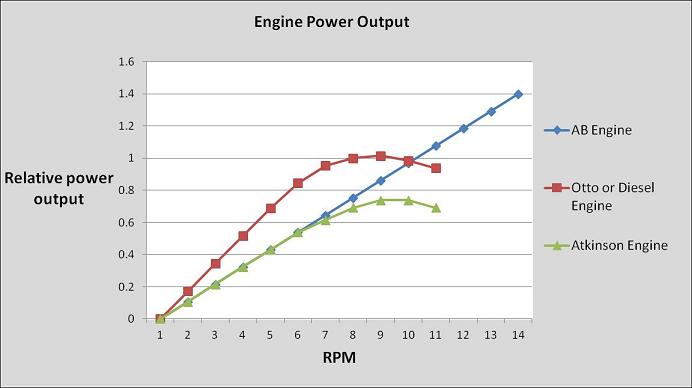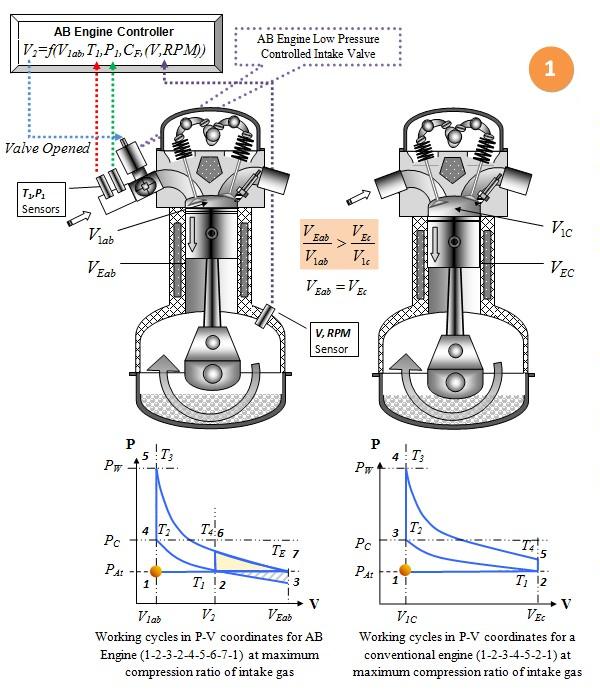"High Efficiency Internal Combustion Engine" Patents Portfolio For Sale
AB Engine Incorporated has prepared an Intellectual Property (IP) package for sale to be made available to all interested parties through an eBay auction. The auction will be accessible through eBay’s website within the Patent/Trademarks section of the website.
The auction will start on November 4th at 8:00 AM US Eastern time and will last for a duration of 10 days - eBay Product ID# 271642560177
AB Engine Incorporated is proposing a unique opportunity to internal combustion gasoline and diesel engine designers as well as manufacturers to possess the patented design method that allows for the most efficient internal combustion engine theoretically possible.
With patent priority as of May 29, 2007, this IP portfolio covers multiple possible patent infringements and allows for 13 more years of proprietary design in the vast market where internal combustion engines are used. Mimicking efficiency of the theory behind the Atkinson engine method, the AB Engine method provides the same or greater fuel efficiency for gasoline and diesel based engines without the mechanical complications associated with the Atkinson design. The uniquely designed and electronically controlled intake valves provide enormous variety in engine optimization options related to fuel efficiency and power output. The IP package also protects a unique engine configuration with exhaust gases heat recovery and a single electrical or mechanical output, giving an opportunity to the engine designer to further increase an engine’s efficiency and power output.
This is a unique opportunity for those conducting business related to engines in the automotive, marine and electric generators industries as well as numerous other areas where engines are in use.
Please call 518-557-3510 with any questions or contact us email: contact@abengine.com.
NOVELTY
TECHNIQUES (METHODS) TO OPTIMIZE EXISTING INTERNAL COMBUSTION ENGINE’S EFFICIENCY AND PERFORMANCE
TECHNIQUES (METHODS) TO OPTIMIZE EXISTING INTERNAL COMBUSTION ENGINE’S EFFICIENCY AND PERFORMANCE
IMPORTANCE
STRATEGIC IP FOR AUTO, POWER GENERATOR, MACHINERY, AND SHIP BUILDING ENGINE MANUFACTURERS and DESIGNERS
STRATEGIC IP FOR AUTO, POWER GENERATOR, MACHINERY, AND SHIP BUILDING ENGINE MANUFACTURERS and DESIGNERS
FUEL-EFFICIENT INTERNAL COMBUSTION ENGINE
Since it was first developed more than a century ago, the performance of internal combustion engines (ICE) has suffered from low thermal efficiency mostly due to the low compression-expansion ratios of burnt fuels. AB Engine Incorporated introduces an innovative method that more efficiently converts thermal energy from burned gas, gasoline and diesel fuels into mechanical energy without exceeding the constraints of conventional ICE designs (e.g., Otto and Miller)
VALUE PROPOSITION
The disclosed portfolio describes the most efficient ICE engine theoretically possible, proposing a method that will increase efficiency 20-45% over existing ICE technology. In addition to improvements in fuel efficiency, the AB Engine method reduces noise, engine temperature and exhaust gas pressure, while increasing linear output power with respect to RPM. Moreover, the AB Engine is compatible with different fuel types and intake gas conditions, as well as the Hybrid and Turbocharged engine designs. The AB Engine improves both fuel efficiency and performance without the disadvantages of alternative designs (e.g. Otto, Miller and Atkinson) which involve complex mechanical solutions.
The disclosed portfolio describes the most efficient ICE engine theoretically possible, proposing a method that will increase efficiency 20-45% over existing ICE technology. In addition to improvements in fuel efficiency, the AB Engine method reduces noise, engine temperature and exhaust gas pressure, while increasing linear output power with respect to RPM. Moreover, the AB Engine is compatible with different fuel types and intake gas conditions, as well as the Hybrid and Turbocharged engine designs. The AB Engine improves both fuel efficiency and performance without the disadvantages of alternative designs (e.g. Otto, Miller and Atkinson) which involve complex mechanical solutions.
Priority Date: 05-29-2007
List of “IP”
The IP portfolio is a bundle of US and China patents and a European patent application related to the same invention:
Title: "High efficiency Internal Combustion engine”
Inventor: Alexander Bakharev
Priority: U.S. Serial No. 12/129,595 (3136.001), filed May 29, 2008, which claims priority to U.S. Prov. Appl. No. 60/940,646, filed May 29, 2007
U.S. Serial No.: 13/300,133
Title: HIGH EFFICIENCY INTERNAL COMBUSTION ENGINE
Inventor: Alexander Bakharev
Priority: U.S. Serial No. 12/129,595 (3136.001), filed May 29, 2008, which claims priority to U.S. Prov. Appl. No. 60/940,646, filed May 29, 2007
U.S. Serial No.: 13/300,133
3. European Application “High efficiency Internal Combustion engine” No. 08769823.9 filed December 28, 2009 based on PCT Appl. No. PCT/US2008/065161 filed May 29, 2008
4. Chinese Patent # ZL 2008 8 0100951.9. November 14, 2012 based on Application “High efficiency Internal Combustion engine” No. 200880100951.9 international filling date January 29, 2010 based on PCT Appl. No. PCT/US2008/065161 filed May 29, 2008
The patents and patent application are all assigned to AB Engine Incorporated. The buyer has to send the owner (company or person) all requested information including the address where documents have to be sent and whom to transfer the patents and patent application ownership to. The ownership transfer will be managed by the AB Engine Incorporated patent counsel:
Heslin Rothenberg Farley & Mesiti P.C.
Attorney at Law Victor Cardona
5 Columbia Circle
Albany, New York, 12203
Telephone: +1 (518) 452-5600
Fax: +1 (518) 452-5579
AB Engine Incorporated introduces a New Method (AB Engine Method) to convert burning gasoline, gas or diesel fuels into mechanical energy while still within the bounds of the conventional Otto, Miller, Diesel or similar internal combustion engine (ICE) design constraints. The new method allows for an ICE design with the highest fuel efficiency theoretically possible.
AB Engine was granted by two US Patents: #8,086,386 December 27, 2011 (PDF) and #8,396,645 March 12, 2013
The Company has also China patents #ZL 2008 8 0100951.9 November 14,2012 and patent pending in Europe.
In February 2012, AB Engine Inc. announced that it has designed and completed a high fuel efficiency internal combustion engine (ICE) prototype in order to demonstrate the "proof of principles" behind the AB Engine Technology. Testing the novel AB Engine method and design with an 87 octane rating gasoline yielded 44% (with 28% theoretical prediction) higher fuel efficiency in comparison to a similar conventional engine design (see News & Media for details).
To see AB Engine Method, please, refer to technology page and technology presentation
The AB Engine technology will also improve the efficiency of today’s most efficient vehicle design, the Hybrid design. The combination of the Hybrid design with the AB Engine technology will result in unparalleled mileage per gallon improvements. Implementing AB Engine technology in turbo-charged engines, Miller type, will deliver powerful and improved efficiency engines as well.
|





